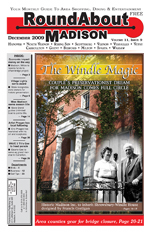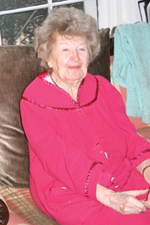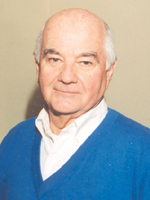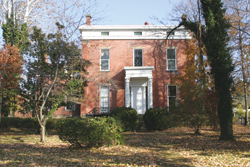



The Windle Magic
Couple’s
preservationist goal
for Madison comes full circle
Historic
Madison Inc. to inherit
Shrewsbury-Windle House
By
Konnie McCollum
Staff Writer
 |
|
December
2009 |
(December 2009) – The community of Madison,
Ind., is about to inherit one of the most outstanding examples of mid-19th
century architecture ever created by famed architect Francis Costigan
with the anticipated passing of the Shrewsbury-Windle House to Historic
Madison Inc.
The late John and Ann Windle founded the non-profit, historic preservation
organization in 1960. John died in 1987; Ann died July 30 at age 98.
In the couple’s will, the impressive house with its freestanding
spiral staircase and massive doorway columns at 301 W. First St. in
downtown Madison is to be given to HMI. An endowment, to be established
by the Windles’ estate, will provide for the future maintenance
and upkeep of the property. It is expected to someday be open for public
tours, according to historic preservation officials. The estate is being
probated in Jefferson County.
“The Shrewsbury-Windle House is the most important surviving piece
of Costigan’s architecture,” said Marsh Davis, president of
Historic Landmark Foundation of Indiana, which is headquartered in Indianapolis.
“Costigan worked out some design issues, and the house is more
refined than some of his earlier work.”
Costigan was commissioned to design the home in 1837 by riverboat Capt.
Charles Lewis Shrewsbury. He was a successful riverboat captain, commission
merchant and flour mill owner who settled in Madison and selected a
choice location facing the Ohio River. Shrewsbury later served as Madison’s
mayor from 1870-72 and died in office.
The Windles purchased the house in 1949 upon moving to Madison from
Chicago. It was added to the National Register of Historic Places in
1994. It is a majestic home built in 1846-1849 in the Greek Revival
style. The house is an example of Regency, a fashion which evolved toward
the end of the period of Classical Revival that pushed vertical line
and measurements higher and higher.
 |
|
Photo
by Don Ward The
Francis Costigan |
The house has 12 rooms, 13 fireplaces and a 53-step spiral
staircase. The staircase, which many say is the best architectural aspect
of the house, is both freestanding and self-supporting. During its construction,
more than 100 men were kept busy on the house with Costigan laying out
the work each day for the supervisors. For his double task of designing
and supervising, Costigan was paid $1.25 a day, the highest price on
the job.
More conservative and restrained in design than the J.F.D. Lanier Mansion,
built a few years earlier by Costigan, the style of the Shrewsbury house
follows closely that of classic Baltimore houses, according to the documentation
presented in the application for its addition to the National Register
of Historic Places. Costigan worked as a carpenter in Baltimore before
arriving in Madison. “Large and cubic in form, the Shrewsbury-Windle
home is built of hand-polished pink brick with a majestic entablature
and cornice that completely surround the house,” according to the
documentation.
Costigan apparently made great use of the carpenter handbooks being
published during the first half of the 19th century, notably the works
of Asher Benjamin and Minard Lafever. The design of the iron fence was
taken from a handbook by Asher Benjamin, as were the palmetto and anthemion
or honeysuckle designs of the iron balconies that flank both the street
and garden entrances.
On the interior, Costigan’s most spectacular achievement is said
to be the spiral staircase. The original design came from Lafever. The
staircase rises from the center of the front hall to the top of the
house and is freestanding and self-supporting. The weight is concentrated
on the bottom step and is carried by the ends of the steps. The curved
drum is made up of four layers of laminated wood, each about a quarter
of an inch thick. The steps are pine, painted white to resemble marble
and the railing is cherry. Where the curved railings become tangent
to the wall, there is a saucer or depression in the plaster that follows
the curve of the handrails so that peoples’ knuckles don’t
hit the wall. The staircase still serves as the air conditioner for
the house where the hot air can rise to the top and escape out of the
attic windows.
 |
|
"The
Shrewsbury-Windle House is the most important surviving piece
of (Francis) Costigan’s architecture." |
Costigan also used a spiral staircase at the Lanier Mansion,
which has often been touted as the crown jewel of Madison’s National
Historic Landmark District. However, instead of freestanding, Lanier’s
circular staircase is tucked demurely into a wall. Shrewsbury’s
stands in the middle of the hallway.
Throughout the interior, Costigan made use of the newest developments
in dimension and proportions. He used greater verticals, taller doors
and higher ceilings than had been used in the country. The full-length
windows have 13 feet of glass.
Another special design evident in the Shrewsbury house is the traffic
pattern. The front hall extends the entire depth of the house, with
the drawing room on the east side and two rooms, a reception room and
a library on the west. Beyond the two west rooms is a wing with two
additional rooms, the dining room and a bedroom. Each of the rooms has
two exits or entrances that allow for a smooth traffic pattern. The
second floor has the same traffic pattern.
“It’s a beautiful home that will be a treasure for HMI,”
said Davis.
Little is actually known of Costigan himself. He was born in Washington,
D.C., on March 4, 1810, and died on April 18, 1865, of tuberculosis.
He opened his own carpentry business in Baltimore in 1835.
Many speculate he decided to move west and settle in Madison because
of the economic hardship his native area was experiencing during that
time. Whatever the reason, he arrived in Madison in 1837, a time when
the town was growing prosperous.
His architectural brilliance heavily influenced other area designers
during his time. He was also responsible for designing many public buildings
in Indianapolis, the city he relocated to after he left Madison.
 |
|
Photo
provided Ann
Windle was |
In Madison, Costigan quickly earned a reputation as being
a master architect. At his own residence at 408 W. Third St., he solved
a difficult architectural problem of fitting a stately and elegant home
on a narrow lot that is only 22 feet wide. The house shows Costigan’s
characteristically fine woodwork, including both curved and sliding
doors and an interesting stepladder staircase with a push gate at the
top. The home is now an HMI-owned property that is open for public tours.
“Costigan’s use of curved wood and curved doors in his designs
is amazing,” said HMI’s programming director Heidi Valco-Kruggel.
He designed a few other residential buildings in Madison, including
the duplex that neighbors his own home. Costigan lived in the home with
his wife, Elizabeth, and three children, Francis, Sarah and Theodore.
In 1851, Costigan moved to Indianapolis. There, he was the supervising
architect on the Institute for the Blind. He later assumed the same
responsibilities for the city’s Hospital for the Deaf and Dumb
and the Hospital for the Insane. He also designed the Odd Fellows Building
and several other residences in the Indianapolis. All of those buildings
have been razed.
In 1858, he designed, built and operated a four-story stucco-ornamented
Oriental Hotel on the northeast corner of Illinois and Chesapeake streets
in Indianapolis. Its name was later changed to the Mason House and then
the Oxford Hotel. In 1928, that building was torn down.
His death was little noticed in 1865, largely in part because it was
a mere two days after the assassination of President Abraham Lincoln.
 |
|
"John
Windle recognized at once the unique and intact architecture of
Madison and set out to make Madisonians aware of how special it
was." |
While the Costigan family was at one time refined and
quite wealthy, that was not the case in later years. His daughter died
a short time after him. The son also died of tuberculosis. In 1884,
Elizabeth Costigan became ill while taking care of her son, and she
died in the same bed as her helpless child.
The family had been reduced to near poverty and would have suffered
had old friends not stepped in to help.
The Shrewsbury-Windle House remained in the Shrewsbury family for many
generations but eventually sat empty for a period until the Windles
purchased it, according to Valco-Kruggel.
The Windles were avid antique collectors. They had learned of Madison
while visiting Ann’s aunt, Jean Anderson, a French professor at
Hanover College for more than 30 years.
Upon John’s retirement from Chicago’s Newberry Library, the
Windles decided Madison would be a perfect spot in which to relocate
and live. While visiting Madison for an antique auction, they found
the Shrewsbury house and knew they had to have it, said John Galvin,
a close friend of the Windles and president of HMI. They bought the
house and grounds for $12,500, and after an extensive restoration and
refurbishing, they moved into it in 1949.
“John Windle recognized at once the unique and intact architecture
of Madison and set out to make Madisonians aware of how special it was,”
said Galvin. “From the time he arrived, until HMI was established
in 1960, he had been laying the groundwork for the preservation organization.”
Galvin said one of the purposes of HMI was to boost and revitalize the
commercial district of downtown Madison and to attract regional business.
Galvin was a merchant on Main Street at the time and was interested
in helping attract business that had left the downtown area for the
hilltop.
 |
|
Photo
by Don Ward The
south side of the house faces |
“John and Ann were Mom and Pop of the preservation
movement. They ran HMI from their home by themselves for almost 10 years.
Without them, Madison may not have ever become a National Historic Landmark
District.”
John died in 1987, but Ann carried on his legacy. For many years, she
opened her home to the public, but in her later years was unable to.
“Ann Windle was a wonderful person through and through,” said
Kim Nyberg, former director of programs at HMI and the current program
manager for the Tennessee Department of Economic and Community Development’s
Community Development Division “Her positive attitude and her sense
of adventure made her the success she was.”
Nyberg said the Shrewsbury House not only has national significance
because of its architectural uniqueness, but is important also because
it also tells the story of the Windles. “Their story is as rich
and important to Madison as the architectural significance of the Shrewsbury-Windle
House”
Davis said it’s befitting that the historic property belong to
HMI.
It’s the natural progression of their life and work,” he said.
“It’s where it all began.”